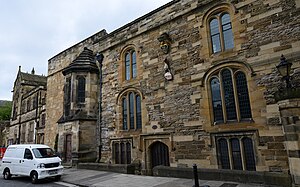This article needs additional citations for verification. (March 2011) |
County Palatine of Durham and Sadberge | |||||||||
|---|---|---|---|---|---|---|---|---|---|
| 883–1836 | |||||||||
 The wards and exclaves of the palatinate. Bedlingtonshire was part of Chester-le-Street Ward, and Craikshire was part of Darlington Ward. | |||||||||
| Status | Prince-Bishopric | ||||||||
| Capital | Durham | ||||||||
| History | |||||||||
• Community of St Cuthbert established | 684 | ||||||||
• Move to Chester-le-Street; Lands granted south of Tyne | 883 | ||||||||
• Move to Durham | 995 | ||||||||
• Bishops' palatine powers recognised | 1293 | ||||||||
• The Act of Resumption curtails civil and judicial independence in the palatinate | 1537 | ||||||||
• Durham returns its first members to Parliament | 1654 | ||||||||
• Tenures Abolition Act ends the bishop's rights as chief feudal lord in the Palatinate | 1660 | ||||||||
• County Palatine formally dissolved | 1836 | ||||||||
| |||||||||

The County Palatine of Durham was a jurisdiction in the North of England, within which the bishop of Durham had rights usually exclusive to the monarch. It developed from the Liberty of Durham, which emerged in the Anglo-Saxon period. The gradual acquisition of powers by the bishops led to Durham being recognised as a palatinate by the late thirteenth century, one of several such counties in England during the Middle Ages. The county palatine had its own government and institutions, which broadly mirrored those of the monarch and included several judicial courts. From the sixteenth century the palatine rights of the bishops were gradually reduced, and were finally abolished in 1836. The last palatine institution to survive was the court of chancery, which was abolished in 1972.
The palatine included the contemporary ceremonial county of Durham except southern Teesdale, the parts of Tyne and Wear south of the Tyne, and had exclaves in Northumberland and North Yorkshire around the island of Lindisfarne and the settlements of Bedlington, Norham, and Crayke.
- ^ "Palace Green Library". Durham World Heritage Site. Retrieved 8 June 2023.

